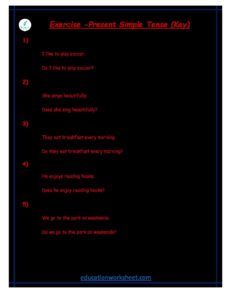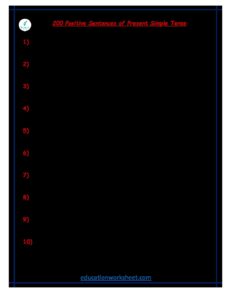Present Simple Tense affirmative examples worksheets
Present Simple Tense affirmative examples worksheets
The English language is a dynamic and versatile tool of communication, comprising various tenses and structures to convey ideas and thoughts effectively. One of the fundamental tenses in English grammar is the Present Simple Tense. This tense is used to describe actions, events, or situations that are habitual, general, or permanent in nature. In this comprehensive guide, we will explore the Present Simple Tense in its affirmative form and provide a multitude of examples to illustrate its usage in various contexts.
I. Basic Structure of the Present Simple Tense
Before delving into affirmative examples, let’s first understand the basic structure of the Present Simple Tense. The affirmative form of the Present Simple Tense is used to make positive statements about routines, facts, and general truths. It primarily consists of the subject, a verb in its base form (sometimes with an ‘s’ or ‘es’ suffix for third-person singular subjects), and, in some cases, additional elements like adverbs of frequency or time expressions.
Present Simple Tense affirmative examples worksheets
The general structure is as follows:
[Subject] + [Base Form of the Verb] (+ [s/es for third-person singular subjects]) + [Additional Elements]
Now, let’s explore various affirmative examples to see how this structure is applied in different contexts.
II. Affirmative Examples
Present Simple Tense affirmative examples worksheets

- Habits and Routines:
- She wakes up at 6 AM every morning.
- They go for a jog in the park every Saturday.
- I read a book before bedtime.
- My dog barks when someone approaches the house.
- Facts and General Truths:
- The Earth revolves around the Sun.
- Water boils at 100 degrees Celsius.
- Cats chase mice.
- The sun rises in the east.
- Permanent Situations:
- I live in New York City.
- She works as a nurse.
- He owns a small bakery.
- They study at the university.
- Timetables and Schedules:
- The train leaves at 8:00 AM.
- The museum opens at 10:00 AM.
- The school closes at 3:30 PM.
- The flight arrives at 6:45 PM.
- Opinions and Preferences:
- I love chocolate ice cream.
- She dislikes horror movies.
- We prefer to travel by train.
- They believe in the importance of education.
- Instructions and Procedures:
- First, you mix the ingredients in a bowl.
- Then, you bake the cake at 350°F for 30 minutes.
- Next, you slice the bread into thin pieces.
- Finally, you serve it with butter and jam.
- Emotions and Mental States:
- He feels happy when he’s with his friends.
- She understands the importance of hard work.
- They appreciate your help.
- I remember our first meeting vividly.
- Scientific Facts:
- The sun emits light and heat.
- Water consists of hydrogen and oxygen.
- Plants photosynthesize to produce energy.
- Sound travels faster in solids than in gases.
- Historical Events:
- Columbus sails to the Americas in 1492.
- The Declaration of Independence is signed in 1776.
- World War II ends in 1945.
- Neil Armstrong walks on the moon in 1969.
- Geographical Information:
- The Amazon River flows through South America.
- Mount Everest is the highest peak in the world.
- Antarctica is the coldest continent on Earth.
- The Sahara Desert covers much of North Africa.
- Customs and Traditions:
- We celebrate Thanksgiving in November.
- They exchange gifts during the holidays.
- People wear costumes on Halloween.
- Many cultures observe wedding traditions.
- Characteristics and Qualities:
- Tigers have stripes on their fur.
- Roses smell lovely.
- Dolphins are highly intelligent animals.
- Diamonds shine brilliantly.
III. Additional Elements
In the affirmative form of the Present Simple Tense, you can include additional elements such as adverbs of frequency and time expressions to provide more context to your statement.
Present Simple Tense affirmative examples worksheets
- Adverbs of Frequency:
- She always arrives on time.
- They usually eat dinner at 7 PM.
- I rarely watch TV.
- He never forgets his keys.
- Time Expressions:
- I play tennis every day.
- We visit our grandparents once a month.
- They clean the house twice a week.
- She reads novels in the evenings.
Present Simple Tense affirmative examples worksheets
IV. Conclusion
The Present Simple Tense in its affirmative form is a powerful tool for conveying information about routines, facts, general truths, and more. By understanding its basic structure and exploring numerous examples, you can effectively communicate in a wide range of everyday situations. Whether you’re talking about habits, expressing opinions, stating facts, or discussing permanent situations, the Present Simple Tense plays a crucial role in the English language, making it an essential concept to master for effective communication.
Present Simple Tense affirmative examples worksheets


